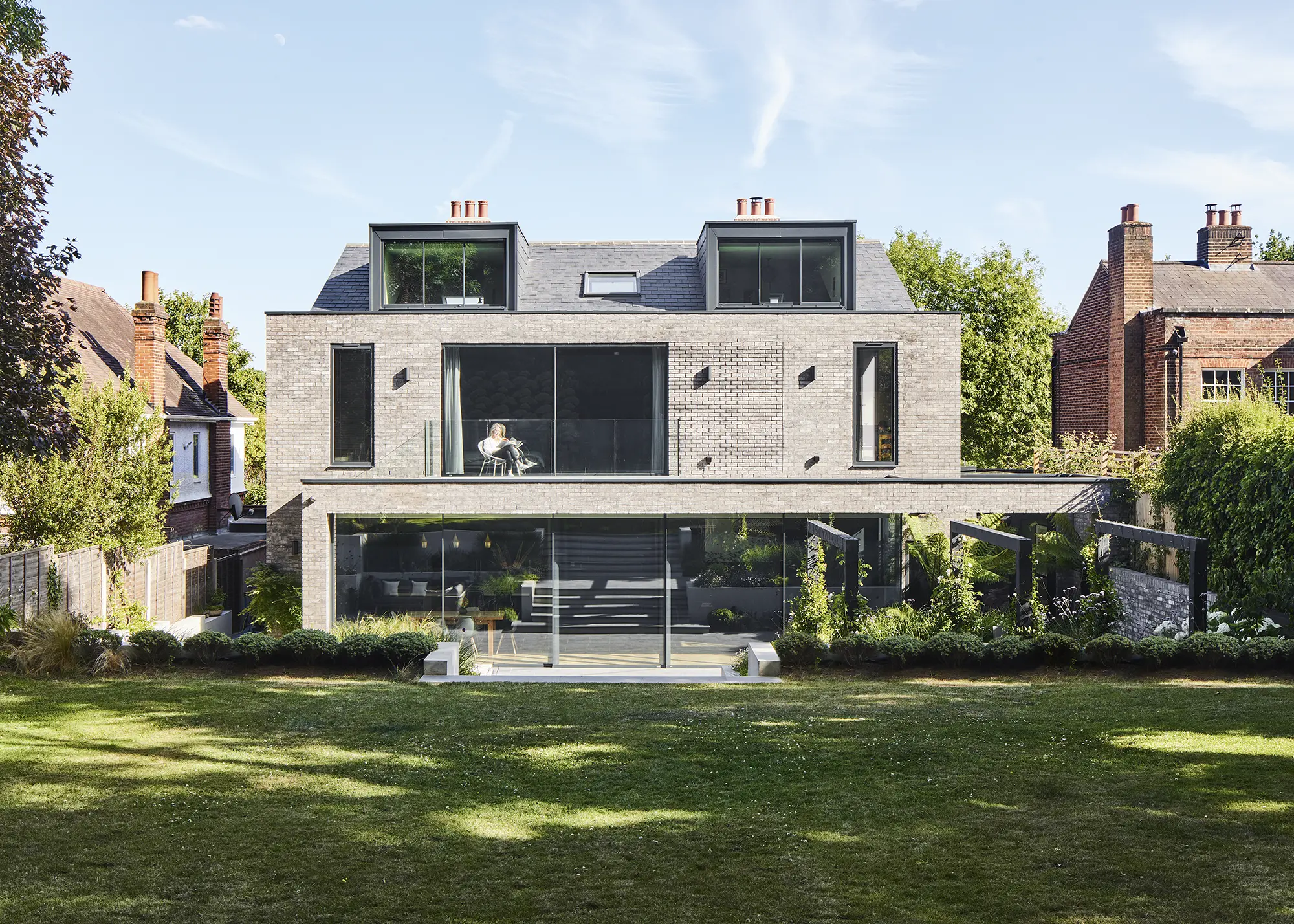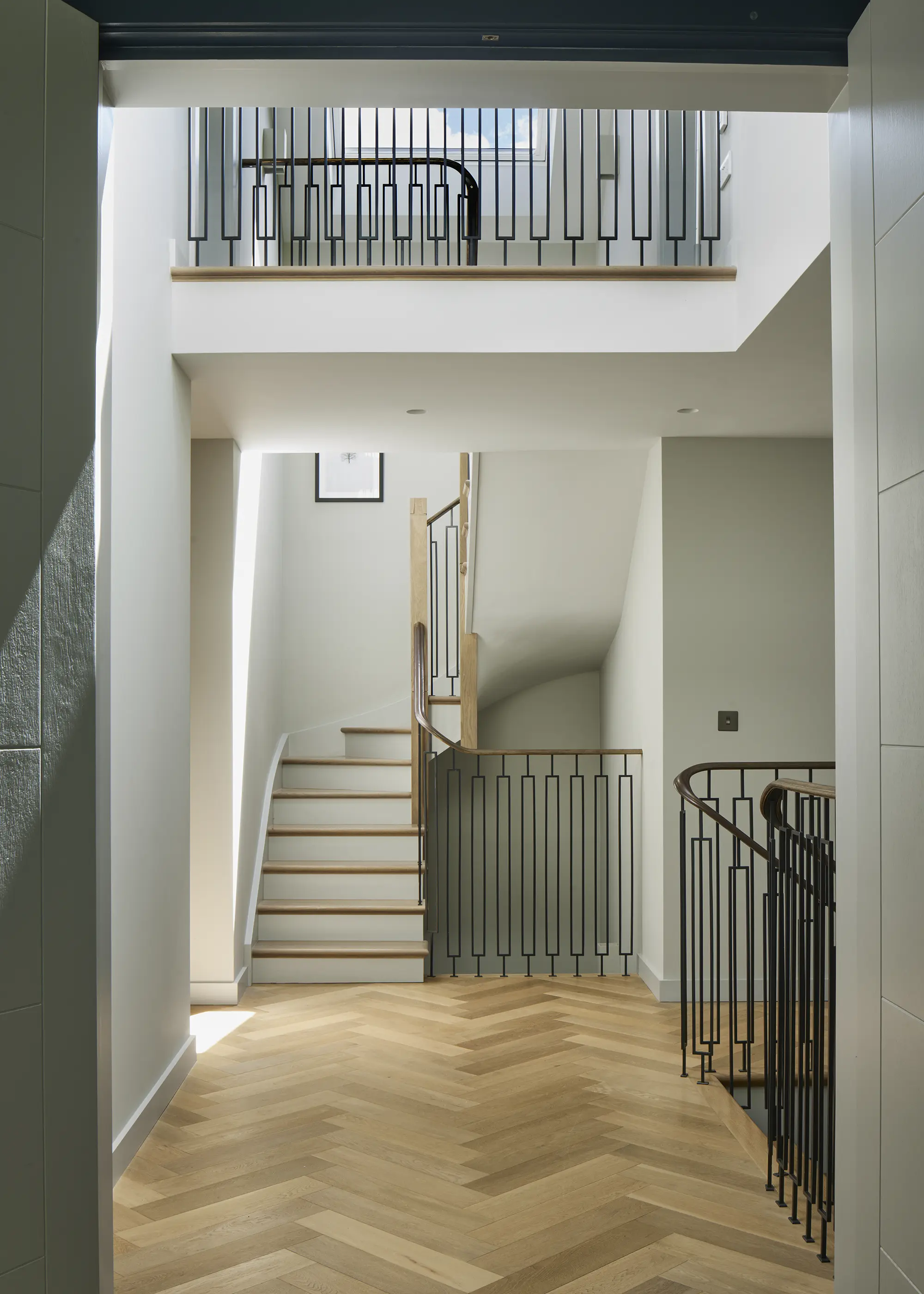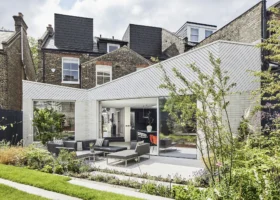

After having their third child, Fiona and Martin Lamb began searching for a bigger home to accommodate the whole family. The couple eagerly embraced the challenge of renovating a property to create their dream home. However, they hadn’t anticipated the full scope of work involved when they purchased a grand neo-Georgian house in Crouch End, London. “We’ve always done work on our previous homes and were prepared to roll up our sleeves and pitch in,” says Fiona. “We thought we were taking on a big renovation project, so we were anticipating some hard work ahead.”
While the 1920s house was liveable, it hadn’t been modernised in decades. It featured small, impractical rooms and poorly considered extensions that left the ground floor feeling disjointed. The rear of the property was also extremely dark. “The garden at the back sloped up into a steep bank, so it felt like being in a basement when you were in the back rooms,” says Martin. “But we loved the home’s location. It’s opposite playing fields, so there’s a lovely sense of space that you don’t tend to find very often in London.”
Recognising its potential, the Lambs knew they needed an architect to help them transform the outdated building into a practical and attractive family home. Their main aim was to create living spaces suitable for their busy day-to-day lives and to draw in more natural light. “Another important thing for us was to make the house feel like part of the garden,” says Fiona. “There’s a big, beautiful plot outside but you just couldn’t see it from inside the house.”
The couple initially approached three design firms and selected Mulroy Architects. “They’d done work for three of our friends, so we had good insight into them as a company and how they worked,” says Fiona. “They are also local, so knew the planning department well and understood what would be permissible. That was a big plus.”

Three distinct zones – a ground-floor living space, first-floor terrace and loft with two symmetrical dormers – ensure the rear of the property contrasts with the traditional facade
Chief architect, Andrew Mulroy, worked closely with Fiona and Martin to reimagine the property. “We knew roughly how we wanted the floorplan to work and had some good design ideas, but we needed Andrew to come in and make them a reality,” says Martin. “Initially, the plan was to renovate, but as the design developed, we realised we were actually altering the majority of the house.” To evaluate their options, Andrew proposed conducting a feasibility study to help them understand the necessary work and spending.
An external company, Potter Raper, was hired to do early-stage cost modelling. The review examined whether it would be more cost-effective and energy-efficient to renovate the existing building or to demolish it and rebuild. “They looked at every aspect of the building and on almost every count, determined it would be more effective for us demolish and build something new,” says Fiona.

The rear elevation features a light, grey brick exterior to ensure a contrast with the front of the period property
Although taking on a self build was never on the cards for the couple, doing so allowed them to create a more spacious layout tailored to their requirements, and integrate a complete thermal upgrade, bringing the house up to modern standards. “By building something new, we were able to improve the flow through to the garden and solve the cold, damp and darkness problems,” says Martin. “We had the added benefit of saving on VAT, too.”
Although not listed, the property lies within the Crouch End Conservation Area and is considered a building of architectural importance. So, Andrew submitted a pre-planning application to determine what would be permissible. Haringey Council came back with a few unexpected stipulations. “We were told we had to retain the front facade of the property, since there’s a replica home next door,” says Fiona. “Everything viewed from the road, including the flank walls, had to look exactly the same as before.”

The staircase is the centrepiece of the home, connecting each of its three main floors. With oak treads, it boasts bespoke steel balustrades and an architectural brass handrail, designed and crafted by Forging Matters
This wasn’t the council’s only requirement. “The rear of the property wasn’t allowed to resemble the front in any way,” says Martin. “The planners wanted it to be very clear which part of the building was old and which was new. So much so that we weren’t even allowed to use the same red bricks at the back.”
To meet the council’s terms, Mulroy Architects proposed constructing a completely new steel frame home behind the original facade. The design incorporated cavity brick and block walls, enabling the use of high-performance Rockwool insulation.

The bedroom opens out onto the balcony via glazed sliding doors, ensuring the lush garden can be enjoyed all year round
Internally, the front four rooms – both on the ground and first floor – would match the original footprint, while the back of the property would feature a spacious living area and kitchen, connected to the garden with contemporary floor-to-ceiling glazed sliding doors. Andrew also proposed moving the staircase to introduce a clear route through the house. The first floor would feature the four bedrooms, plus the master, with two more on the top floor.
Thanks to the design guidelines that were revealed during the pre-planning process, consent was achieved in three months and the project was put out to tender. “Martin and I had no clue about builders, but Andrew had lots of recommendations,” says Fiona. “Around eight companies responded and we whittled them down to three.” The couple chose Kantec Bespoke after visiting a few of their recent projects and speaking with their clients. “We did a lot of due diligence, so we felt confident in our decision.”
CLOSER LOOK Retaining the front elevationThe neo-Georgian home – designated of local importance – lies within the Crouch End Conservation Area. “This meant that we couldn’t knock down the facade, since it matched the neighbouring property,” says architect Andrew Mulroy. “To overcome this, we demolished the existing house, setting aside the bricks for re-use, and propped the front elevation up using a steel frame.” Kantec Bespoke dug deep trenches in the front garden and inserted four or five huge concrete feet into them. “These pillars held the steel frame that essentially propped up the front of the house,” says Andrew. “This maintained its structural stability while the rear of the property was rebuilt.” It was a delicate and risky task, so Fiona and Martin took out a structural warranty policy with Build-Zone. Heritage consultants, WS Heritage, were also hired to provide advice and assistance. |
Chief contractor, Andy McCondach, took on official project management duties, but Andrew, Fiona and Martin were all heavily involved throughout to ensure the project stayed on budget. The couple sold the home they were living in at the time and began renting locally, so they could be present on site as often as required.

The back garden had a slope, both front to back and left to right, so Fiona chose to incorporate terracing to create distinct areas for dining, relaxing and entertaining. The hard landscaping is softened by naturalistic planting
Work began in February 2019 with the demolition of the existing structure. Since the local planners specified that the flank walls of the house couldn’t be changed, the team at Kantec Bespoke had to painstakingly dismantle the external walls. Each brick was retained, cleaned and safely stored, to be reused for the new side walls when the time came. Once the original home was demolished, only the neo-Georgian facade remained.
To ensure its structural stability, the front elevation had to be supported. “Kantec Bespoke installed a huge steel frame to prop up the face of the house,” says Martin. Akin to a giant Meccano set, the frame proved to be a stressful and costly part of the project.
However, the challenges didn’t stop there. Before Kantec could begin laying the foundations, the heavens opened. “The weather was terrible,” says Fiona. “It rained incessantly for weeks, so the team couldn’t get machinery on site – it was too dangerous and slippery.” Due to the weather conditions, the Lambs were left with a muddy, clay-filled hole in the back garden for a whole month.

The open plan living space is Fiona and Martin’s favourite area. Neatly divided into a kitchen, dining zone and lounge, the space is fully integrated with the garden, thanks to frameless, floor-to-ceiling sliding doors, specified with solar-protected glass
Compounding the challenges, the Covid-19 pandemic struck in early 2020. The site was shut down for about three weeks – the glazing subcontractor couldn’t find a way to crane the glass and install the windows while maintaining the required two-metre social distancing. “At this stage, we had quite a few, ‘what on earth are we doing’ moments,” says Fiona. “Luckily, once Kantec were able to get going on site, the house went up relatively quickly.”
The project began with the installation of concrete foundations and a beam-and-block suspended ground floor. Following this, the new house was built behind the preserved front elevation. The landscaping took place at the same time – Fiona, a garden designer, liaised with Andrew to ensure the outside space would work perfectly with the house. “We dug out the slope at the back to create more distance between the garden and the rear rooms,” says Fiona.
“We did all the formation work for the terracing at the start of the build. I wanted to create lots of different zones within the garden, just like we designed inside the house. I also brought the planting right up to the main structure, so even when you’re inside, you get the benefit of feeling connected to the exterior.”
In July 2022, the work was finished. Despite the challenges, the couple are thrilled with their new home and found the self build experience rewarding. “Both Andrew and Andy were fantastic to work with, especially given what we were up against,” says Fiona.
From the front of the house, nothing appears to have changed – save for a sensitively planted garden, paved driveway and new triple-glazed, heritage windows. The exterior was also repointed with lime mortar, to ensure a fresh finish. The front door opens into a light-filled entrance hall, with cosy reception rooms at either side.

Frameless, full-height glazed sliding doors, specified with solar-protected glass, open onto the garden
Beyond these spaces, the new custom staircase sits at the heart of the home, with an open-plan living area, dining room and kitchen at the back, connected to the newly landscaped garden via glazed doors. Fiona took charge of the home’s interior design, encouraged by Andrew to take bold risks with her colour choices. From the soft greys of the corridors to the bold, dark shades of the kitchen and lounge, alongside gold accents and rich blues elsewhere in the home, the property’s contrasting scheme cleverly echoes the juxtaposition of its unique exterior.
Not only has the house been transformed aesthetically; its energy efficiency has also been upgraded significantly. “Thanks to the new windows and high levels of insulation, the home’s energy rating increased from SAP band F to B,” says Martin.
For the Lambs, the most rewarding part of the process was seeing the house come together so quickly after a frustratingly slow start. “It was amazing to watch the building develop right in front of our eyes,” says Fiona. “Each stage was a big learning curve, but really exciting nonetheless.”
Their favourite room is the open plan kitchen and living area – a wonderful light-filled space that truly feels like part of the garden, just as they’d set out to achieve. “It’s such an airy, happy environment,” Fiona continues. “It’s great for both unwinding with some low-key family time and entertaining friends.”
Although they’re not deterred from taking on another project later down the line, for now the Lambs are very content with what they’ve worked so hard so build. “The property works perfectly for us and our whole family,” says Fiona. “We’ve managed to create a house that’s more interesting and individual than we could have imagined thanks to the planning constraints, so we have no regrets.”
Knock-Down & Rebuild Home with a Neo-Georgian Facade
WE LEARNED…
|
